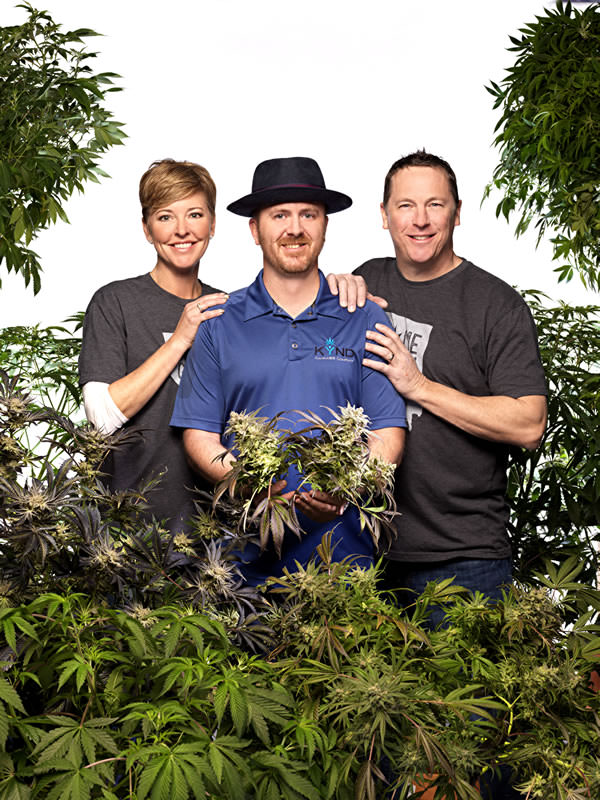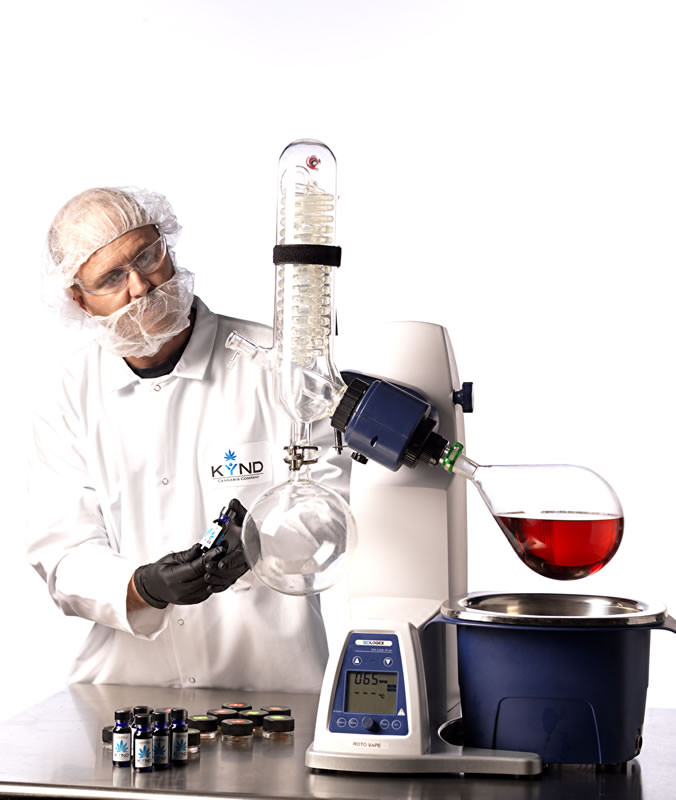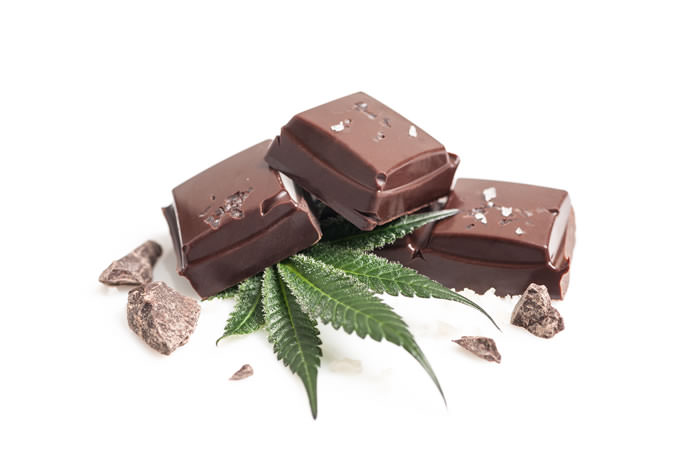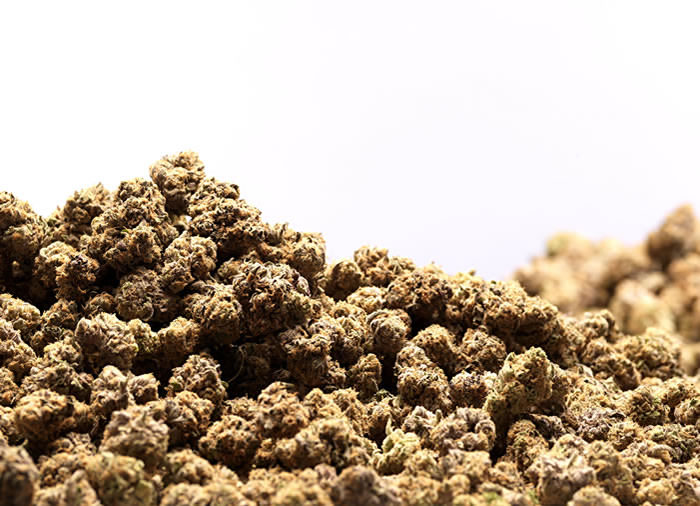cover
SIERRA HIGH
Exploring the cannabis rollout with our area’s pot pioneers.
WRITTEN BY HEIDI BETHEL
PHOTOS BY JEFF ROSS
As Nevada and California jump on the recreational marijuana bandwagon, those aiming to bring cannabis to market are working their way over the hurdles. Business professionals, regulators, and agriculturists are trying to define and understand stipulations dictating growing practices, dispensary locations, packaging, water use, and more.
Along with figuring out terms and conditions for growing and selling come decisions about which products to manufacture. No longer is cannabis consumed only with joints and pipes. In addition to traditional inhalation methods, vaporizers are gaining in popularity. Products also are consumed orally, topically, and sublingually. The variety of products is seemingly endless, including edibles.
Building on the groundwork laid for medical marijuana use (approved in Nevada in 2000 and California in 1996 — and amended in 2004 and 2015), cannabis producers are forging a new industry — one that could bring big bounty to The Silver State, The Golden State, and beyond.
After the smoke clears
In November 2016, voters in Nevada and California approved an initiative to allow recreational marijuana use for adults. But while citizens’ voices were clearly heard on the topic, defining necessary infrastructure to support the rollout in both states was relatively unclear.
In a nutshell, once the laws went into effect, consumers could legally possess and use marijuana, but no licensed dispensaries existed from which to purchase it. This instilled fear in lawmakers that the black market would boom beyond measure. In Nevada, officials at the department of taxation have until Jan. 1, 2018 to create a path to licensing for recreational marijuana sales. In the meantime, owners of currently licensed medical marijuana dispensaries may apply to sell to those 21 years and older. California is under a similar stipulation, with the same deadline in place for the bureau of marijuana control.
Among the players involved in advising lawmakers overseeing the genesis of the recreational marijuana initiative in Nevada are the leadership team behind Kynd Cannabis Co. and Mynt Cannabis Dispensary: Mark Pitchford, Scott Dunseath, Joanna O’Neal, and Dr. Sean Devlin. Their experience being among the region’s first and top producers and cultivators of medical marijuana lends itself nicely to the new task at hand. Having been through cumbersome training, yearly audits, and surprise inspections, combined with their knowledge about growing cannabis and serving patients, and their strong connection to the community and success operating a medical marijuana business, all have proven instrumental thus far.
Kynd was second in the state to nab a production license to grow cannabis for medical purposes — this was in November 2014, more than a decade after medical marijuana became legal in Nevada.
“It’s been a learning curve for us and those we’ve worked with from the city, county, and state offices. Construction and interpretation of how the medical use law was written and homogenizing across the board was a challenging process,” says Pitchford, who is Kynd’s CEO and has been working with marijuana for more than 25 years, giving him an intricate understanding of growing cannabis and its medicinal value.
“At the end of the day, we got through it, and things have become easier over time,” Pitchford adds. “We work hand in hand with the regulators, producing positive results for our patients and the industry in general. Our hope is to take the same approach to recreational use.”
Quality wellness
Open dialogue has made the wellness aspects of cannabis more widely known and accepted. Studies have shown there is a general consensus that marijuana helps in treating certain medical ailments. In a comprehensive review, National Academy of Medicine researchers concluded marijuana may be modestly effective for pain relief (particularly nerve pain), appetite stimulation for people with AIDS wasting syndrome, and control of chemotherapy-related nausea and vomiting.
Dr. Usha Kiran Nuthi incorporates cannabis in treatment measures at the Fountain of Youth Wellness and Medical Spa in Reno. She’s had great success using the medicine to alleviate symptoms across a spectrum of conditions.
“Over the past few years, I’ve tracked patients with multiple sclerosis, intractable epilepsy, and chronic pain from migraines,” Nuthi says. “They may not get off all of the traditional medications, but they have been taking less and suffering from fewer side effects.”
She touts the stabilizing, anti-inflammatory, and pain control aspects of the plant, stressing that the benefit of incorporating cannabis in conjunction with traditional medicines is ideal and should be considered an option for many patients.
“My parents are in their 70s and 80s,” says Dunseath, vice president of marketing with Kynd and founder of Reno eNVy clothing line. “The last time we had the conversation about cannabis was when I was in high school and got into trouble. Now we have the running joke, ‘Have you had the talk with your parents?’ They need to know there are options out there.”
In a world that increasingly prizes organic produce, the professionalism and care the Kynd team takes with its products is not something that was commonplace when cannabis was only sold on the black market.
“We have a controlled product that has been tested, and the state receives the tax benefit, making the market much safer,” Pitchford says.
“You can compare it to bootlegging,” Dunseath adds. “During Prohibition, you would get moonshine and didn’t know what you were getting. If you buy [pot] off the streets, you don’t know where it was grown, the pesticides used, or if there’s mildew in it. With us, you know it’s a clean product and it’s safe.”

Creative cultivation
Though growing practices now are regulated and, therefore, safer, growing marijuana outdoors still may be prohibited in some cities, despite the new law. This has resulted in a surge in commercial real estate, with more than a $300 million estimated influx into the Washoe County market alone. This money has been invested primarily into abandoned warehouses and buildings located inside what the industry calls Green Zones, or areas approved for growing, as determined by the regulators. In Nevada, Medical Marijuana Establishments only are allowed to be located in commercial- and industrial-zoned areas on parcels that meet the buffering requirements of 300 feet from community facilities and 1,000 feet from schools.
“When this started, we spent months and months of time getting buildings approved. We had to do GIS (Geographic Information System) surveys making sure we were within those Green Zones,” Pitchford says.
Then comes the water use. In the initial lobbying efforts against medical marijuana, the authorities from local water districts were concerned there would be overuse of what may already be a limited supply of water. This is where water catchment systems come in, to recirculate the precious H2O.
“The funny thing is, we spend more money on our bill with Sparkletts to deliver water for our employees to drink than we do with [the Truckee Meadows Water Authority],” Pitchford says.
The Kynd team has successfully developed more than a dozen high-grade strains of cannabis that have been extensively tested by Certified Ag Lab, a medical cannabis testing laboratory in Sparks. With both THC and CBD strains, Kynd grows the full spectrum of cannabis plants — from sedative indica varietals to energetic sativa plants. With names such as Cadillac Purple, Gorilla Glue No. 4, Orange Cookies, and Sour Diesel, each strain is developed for a specific use and unique effect. Employees at this boutique grower cultivate the individual strains in six rooms.
In designing their facility, the founders combed through the testing standards determined by the state as well as best practices from growers in Colorado, Washington, and California.
“We split our plants into different rooms,” Dunseath says. “If we were to ever have an issue with any of our cannabis, we wouldn’t lose an entire crop.”
Pitchford adds that in instances where a whole plot is under one canopy, the likelihood of cross contamination is high should disease or pests strike.
“We have small, closed systems in self-contained rooms,” Pitchford says. “At the end of the day, we come out with a cleaner, safer, better program and product.”
Wine to weed
Daniel Hopper, cultivation manager with Silver State Relief in Reno, is incorporating his background researching wine grapes through the University of Nevada, Reno, into the work he does for this medical marijuana dispensary. During his studies, he applied drought stress to wine grapes to produce a higher quality fruit. He’s used this practice with marijuana as well.
“We believe we are able to enhance certain aromas and taste compounds with drought stress in cannabis,” Hopper says. “Because it’s been grown independently for so long, there really has been an insignificant amount of research on proper growing techniques.”
Under Hopper’s guidance, growers at Silver State Relief also have conducted lighting analyses and tinkered with several plant hybrids.
“We’re right in the middle of this big transition from home growers to large-scale agricultural growers,” Hopper says. “Applying streamlined processes to growing cannabis, learning all we can about indoor lighting, and determining the best nutrients for our plants will produce a superior medicine for our customers.”
Recreational options
Flower. Pre-rolled. Vaporizer. Oil. Balm. Dab sap. Tincture. Capsule. Honeycomb. Wax. Shatter. Crumble. Sugar. The vast menu of marijuana products out there and the plants used to make them are not like the skunky bud in a bowl or Cheech and Chong-like bong hit that the images from the 20th century would have us imagine.
“Traditional marijuana smoking is a take-it-all approach,” says Shauntel Ludwig, director of sales and marketing for DaVinci, a vaporizer manufacturing company with distribution in Nevada and California. “The user is burning or combusting the entire herb, therefore taking all of the cannabinoids, terpenes, and everything else. Vaporization tends to feel a bit milder, especially at lower temperatures, since only specific terpenes and cannabinoids are being activated.
“Think of smoking versus vaping as taking a shot of tequila versus sipping a fine wine,” she says. “If you drink enough wine … you’ll eventually be just as drunk.”
“We have all different strains and ways to use them. And there’s a different way to store and consume each type,” says Bree Kasper, manager at Blüm Reno.
With two dispensaries in Vegas, one in California, and one in Reno, plus two more in the works in the Bay Area, Blüm carries a wide selection of products for its patients.
“It’s important to know the best way to use any cannabis product safely and not to overdo it,” adds Mikel Alvarez, Blüm’s general manager.
Alvarez encourages new customers to speak with the professionals to determine the optimal plant and product to use and how to properly consume it.


Dope edibles
Companies such as Kynd are making it even easier to reach the ideal high with their lines of tincture-infused treats. Working with a local chocolatier, Kynd’s team have developed milk chocolate and dark chocolate sea salt bars, with caramels and about 10 other varieties of edibles on the way. The company recently opened its offshoot, Mynt, the only downtown Reno dispensary, where customers can purchase locally made items.
“We take pure flower to make our high-quality oils that we use in the tinctures for our edibles,” Pitchford says. “Unlike some who use trim and scraps, we pride ourselves on using the best ingredients for a superior product.”
It doesn’t stop at chocolate and caramel. Home cooks are integrating marijuana into all types of dishes.
“Cannabis can be infused into any kind of fat, so the possibilities are limitless when it comes to integrating it into any kind of cuisine, savory or sweet,” says Elise McDonough, edibles editor at High Times magazine and author of The Official High Times Cannabis Cookbook.
Most popular for cooking is cannabutter. This combination of ground cannabis, alcohol, and butter can be used to replace its oleo counterpart in any recipe — making for one versatile ingredient for baking, savory recipes, and more. The trick is finding the right cannabutter concoction. (High Times’ recommended recipe is provided here[JS1] .)
McDonough explains that ingesting cannabis provides a more intense, long-lasting experience compared to other means of ingestion, and that it can take up to two hours to feel anything.
“Go low and slow,” she says. “If you are cooking with cannabis at home, be careful to avoid cross contaminating any cooking gear used by another family member, and always clearly label pot foods so as to prevent an accidental ingestion. Educate yourself with a cannabis cookbook, and be cautious with the amount of cannabis used. Always sample a tiny piece of homemade edibles and wait two hours to see how strong the effects will be before eating more or serving them to others.”
With Pandora’s pot box now open and businesses sprouting in California and Nevada, the trail may be a bit hazy. But one thing’s for sure: There is a slew of passionate professionals leading the way to an enlightened, cannabis-filled future.
Heidi Bethel sees the value in making marijuana legal across all spectrums, from a wellness perspective to the taxable sales for the states. Like the others in this story, she urges folks who are interested to visit their local dispensary and speak with the experts.
RECIPES
Cannabutter
(courtesy of Elise McDonough, edibles editor, High Times magazine and author of The Official High Times Cannabis Cookbook. Makes ½ cup)
½ ounce cannabis flower
1 ounce Everclear grain alcohol in spray bottle
8 ounces clarified butter
Preheat oven to 240 degrees F. Grind flower in blender or food processor. Spread ground flower evenly on bottom of sheet pan and place on center oven rack.
Bake 1 hour, stirring once halfway through. Make sure flower stays evenly spread. Remove pan from oven and cool 10 minutes.
Spray fine mist of Everclear over toasted flower. This step helps break down cellulose slightly, allowing for less green infusion color. If you don’t have spray bottle, use teaspoon and sprinkle Everclear on cannabis flower while stirring with spoon. Let flower sit for 10 to 15 minutes. Meanwhile, begin melting butter over low heat.
Since flower is already decarboxylated, butter only needs to be hot enough to extract cannabinoids. A slow simmer is good. Spoon flower into butter and stir. Extract using slow cooker set on low for 6 hours, and stir every hour or so to prevent burning.
Once infusion is done, remove from heat and let cannabutter cool at least 20 minutes. Line metal strainer with cheesecloth. Pour butter through cheesecloth and use spoon to press all infused cannabutter out.
Now your cannabutter is ready to use in recipes! Refrigerate and use within two weeks.
Kushy Caramel Cakes
(courtesy of Elise McDonough, edibles editor, High Times magazine and author of The Official High Times Cannabis Cookbook. Serves 6)
2 cups white chocolate chips
1 cup all-purpose flour
¼ cup sugar
¼ cup butter, plus more for ramekins
2 cups dulce de leche
¾ gram of de-carbed cannabis concentrate (This much concentrate should allow for about 100 mg. per serving, for quite a potent little treat.)
Maldon or flake sea salt for sprinkling (optional)
Butter six ramekins and preheat oven to 425 degrees F. Create double boiler by placing metal mixing bowl over large pot with 1 inch of water in it. Bring water to boil and place white chocolate chips in mixing bowl. Reduce heat to keep water steadily simmering.
Melt white chocolate with cannabis concentrate over low heat, making sure to stir constantly; when melted, add dulce de leche and stir until incorporated. Remove from heat and set aside.
Using stand or hand mixer, beat butter with sugar until mixture is creamy. Add eggs one at a time, mixing between each addition, until mixture is pale and has doubled in volume, about 5 to 7 minutes. Gradually add white chocolate mixture. Shake flour slowly, a little bit at a time to avoid lumps. Mix until completely combined.
Divide batter among 6 ramekins. Sprinkle tops with sea salt if desired.
Bake cakes until golden brown but centers are still slightly soft, about 15 minutes.
Serve warm … perhaps with some vanilla ice cream or some Chantilly cream.
Cheba Cheddar Dill Scones
(courtesy of Elise McDonough, edibles editor, High Times magazine and author of The Official High Times Cannabis Cookbook. Serves 15)
4 cups plus 1 tablespoon all-purpose flour, divided
2 tablespoons baking powder
1 to 3 grams water-based hash (optional)
2 tablespoons finely chopped onion
2 teaspoons salt
28 tablespoons cold unsalted butter, diced
4 tablespoons cold cannabutter, diced (optional)
4 extra-large eggs, beaten lightly
1 cup cold heavy cream
½ pound extra-sharp yellow cheddar, shredded
1 cup minced fresh dill
Egg wash: 1 egg beaten with 1 tablespoon water or milk
Preheat oven to 400 degrees F. Combine 4 cups flour, baking powder, and salt in bowl of electric mixer fitted with paddle attachment. Add butter (plus cannabutter, if using) and mix on low until butter is in pea-sized pieces.
Mix eggs and heavy cream, and quickly add them to flour-and-butter mixture. Combine until just blended.
Toss cheddar, dill, and 1 tablespoon flour together and add to dough. Mix until ingredients are almost incorporated.
Dump dough onto well-floured surface and knead for 1 minute, until cheddar and dill are well distributed.
If using scone tray, spray with vegetable oil and fill with spoon. If using baking sheet, roll dough to ¾ inch thick. Cut into 4-inch squares and then in half diagonally to make triangles. Place on baking sheet lined with parchment paper.
Brush tops with egg wash and bake for 20 to 25 minutes, until outsides of scones are crusty and insides are fully baked. Consume within a day. Storing scones in fridge will make them less crispy.
Vanilla Cannabutter Cake and Cream Frosting
(courtesy of Elise McDonough, edibles editor, High Times magazine and author of The Official High Times Cannabis Cookbook. Serves 24)
2¾ cup cake flour
2¾ cup sugar
1 teaspoon baking powder
1 teaspoon salt
½ cup egg whites
½ cup warm water
⅓ cup sour cream
8 tablespoons butter
2 tablespoons cannabutter
3 tablespoons expeller-pressed canola oil
1 teaspoon Gahara vanilla bean paste (or scrape two vanilla bean pods)
Line cupcake tin with your favorite cupcake wrappers and preheat oven to 350 degrees F.
Combine dry ingredients in mixer on low speed. In separate bowl, combine water and sour cream. Add vanilla paste and egg whites to mixture and stir until combined. Add butter, oil, and ¼ of liquid mixture to dry ingredients. Mix on low until moistened. Increase to medium speed and mix for 1 minute. Scrape sides of bowl and gradually add remaining liquid mixture in three doses, beating for 20 seconds after each dose.
Scoop batter into wrappers, filling them ¾ full. Bake 25 to 35 minutes or until edges are slightly golden brown. Set cupcakes aside until cool to the touch before frosting with cannabutter cream frosting.
For frosting:
1 cup unsalted cannabutter, softened
1½ teaspoon vanilla extract (fine vanilla extract, like Madagascar Bourbon Vanilla, recommended)
½ teaspoon salt
3 cups powdered sugar
1 to 2 tablespoons milk
1 to 2 drops green food coloring
In standing mixer fitted with paddle attachment, mix together salt and butter until creamy. Add vanilla and blend until incorporated. Slowly add powdered sugar and mix on low speed until well blended, light and fluffy. Scrape bowl, especially bottom! Add milk, and beat on low just until combined, adding more milk if more spreadable consistency is desired. Add food color and blend well.
Use right away on completely cooled cupcakes or refrigerate for up to 2 weeks.
Sativa Shrimp and Ganja Grits
(courtesy of Elise McDonough, edibles editor, High Times magazine and author of The Official High Times Cannabis Cookbook. Serves 4)
2 cups water
2 cups chicken stock
Salt and pepper
1 cup stone-ground grits
3 tablespoons cannabutter
2 cups shredded sharp cheddar cheese
1 pound shrimp, peeled and deveined
6 slices bacon, chopped
2 tablespoons parsley, chopped
1 cup scallions, thinly sliced
1 large clove garlic, minced
½ teaspoon red chili flakes
Garlic powder
Combine water and stock and bring to boil. Add salt and pepper. Add grits and cook until water is absorbed, about 20 to 25 minutes, stirring frequently. Remove from heat and stir in cannabutter and shredded cheese.
Rinse shrimp with water and pat dry with napkin. Season shrimp with salt and pepper, red chili flakes, and garlic powder. Fry bacon in large skillet until browned, then add garlic, being careful not to burn garlic. Remove bacon from pan, leaving grease, and add shrimp. Cook shrimp until tender, just a minute or two. Add chopped bacon, parsley, scallions, and garlic to pan. Sauté 3 minutes. (If desired, add ½ tablespoon cannabis-infused olive oil to shrimp.)
Spoon grits into serving bowl. Add shrimp mixture on top. Serve immediately.
German Canna Chocolate Stout Cupcakes
(courtesy of Elise McDonough, edibles editor, High Times magazine and author of The Official High Times Cannabis Cookbook. Serves 12)
¾ cup cocoa powder
2 cups organic cane sugar
2 cups all-purpose flour
1 teaspoon baking soda
½ teaspoon salt
1½ cups stout beer
2 ounces butter, melted and cooled to room temperature
2 ounces cannabutter, melted and cooled to room temperature
1 tablespoon vanilla extract
3 eggs
German chocolate cake filling (recipe below)
Chocolate frosting (recipe below)
¼ cup toasted flaked or shredded sweetened coconut, for garnish
¼ cup chocolate curls or mini-chocolate chips, for garnish
Preheat oven to 350 degrees F. Place cupcake liners in muffin or cupcake tin. Whisk cocoa powder, cane sugar, flour, baking soda, and salt in large mixing bowl, and mix beer, butter, vanilla extract, and eggs in smaller bowl. Add wet ingredients to dry, mixing just until smooth, with no lumps. Fill each cupcake liner ¾ full. Bake 12 minutes, rotate pan 180 degrees, then bake for another 10 minutes. Cool cupcakes on baking rack.
With an apple corer or small spoon, remove ½-inch core from center of each cupcake and fill with German chocolate filling. Frost tops, and garnish with coconut and chocolate.
For filling:
1 cup sugar
1 cup evaporated milk
4 ounces cannabutter
3 eggs
1⅓ cup shredded, sweetened coconut
1 cup chopped pecans
1 tablespoon vanilla
In medium saucepan, combine sugar, milk, butter, and eggs. Cook over medium heat, stirring constantly, until mixture starts to bubble and thicken. Remove from heat and mix in coconut, pecans, and vanilla. Let cool to room temperature.
For frosting:
8 ounces unsweetened chocolate
8 ounces butter, room temperature
4 ounces cannabutter, room temperature
1 pound powdered sugar
1 tablespoon vanilla extract
Microwave chocolate at 30-second intervals, being careful not to burn it, until melted. Alternatively, use double boiler to melt chocolate. Cool to room temperature. In large bowl, set electric mixer on low speed and beat together butter, powdered sugar, and vanilla until creamy and fluffy — about 3 minutes. Mix in melted chocolate. Let cool.


